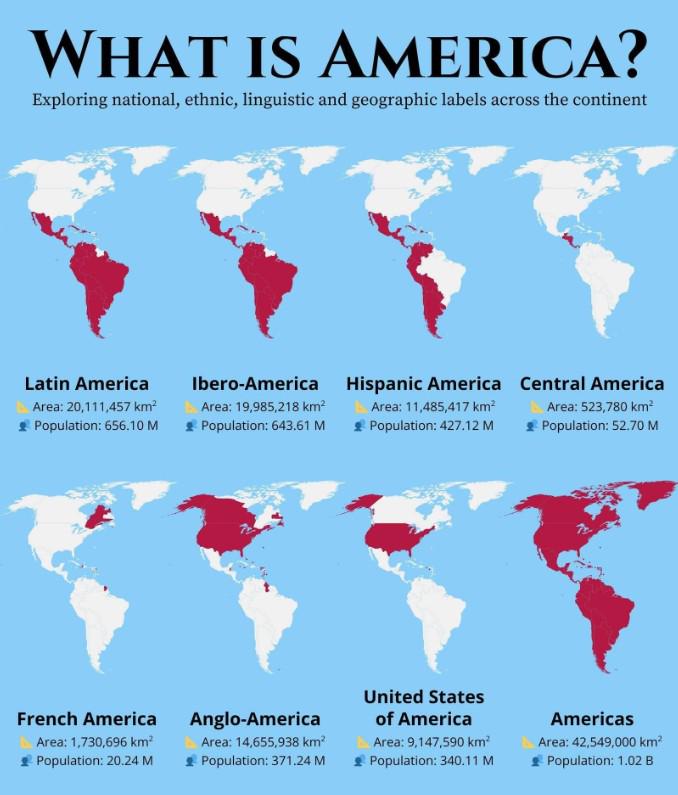National and Ethnic Labels Map of America


David Chen
Data Visualization Specialist
David Chen is an expert in transforming complex geographic datasets into compelling visual narratives. He combines his background in computer science ...
Geographic Analysis
What This Map Shows
The map titled "What is America?" provides a detailed visualization of the diverse national, ethnic, linguistic, and geographic labels that characterize the continent of North America. By highlighting these various identities, the map offers a snapshot of the complex tapestry of cultures and groups that define what America is today. From the indigenous populations to the immigrant communities that have shaped the continent, this map serves as a crucial resource for understanding the multifaceted identity of America.
Deep Dive into National and Ethnic Labels
America is often described as a melting pot, a phrase that encapsulates the blend of cultures, languages, and ethnicities that inhabit this vast land. However, the reality is more nuanced than simply mixing different ingredients into one dish. The rich diversity of the continent is reflected in a plethora of national and ethnic labels that vary widely from region to region.
Interestingly, the United States alone is home to over 300 ethnic groups. According to the U.S. Census Bureau, as of 2020, more than 60 million individuals identified as Hispanic or Latino, making it the largest minority group in the country. This demographic shift has significantly influenced American culture, from cuisine to music, and has led to the emergence of vibrant Hispanic communities, particularly in states like California, Texas, and Florida.
Moreover, the influence of African Americans is profound, with their roots tracing back to the transatlantic slave trade. Today, African Americans make up approximately 13% of the U.S. population and have played a pivotal role in shaping the social, cultural, and political landscape of the nation. The cultural contributions can be seen in various realms such as literature, art, and civil rights movements.
In addition to these major groups, the map reveals the presence of various Asian American communities, including Chinese, Indian, and Filipino populations. The Asian American demographic has seen exponential growth over the past few decades, with the Pew Research Center estimating that they will constitute nearly 10% of the U.S. population by 2050.
Indigenous peoples also hold a significant place in America's ethnic landscape. The U.S. is home to over 574 federally recognized tribes, each with its unique language, cultural practices, and historical narratives. Despite facing historical injustices and ongoing challenges, Indigenous communities continue to thrive, preserving their traditions while also engaging in contemporary issues such as land rights and environmental protection.
Regional Analysis
The map illustrates how these ethnic and national labels manifest differently across various regions of North America. For instance, in the Northeast, cities like New York and Boston are renowned for their diverse immigrant populations, contributing to rich cultural mosaics. New York City alone is home to vibrant neighborhoods like Chinatown and Little Italy, showcasing the Italian and Chinese immigrant experiences.
In contrast, the Southern U.S. reveals a different picture, with a considerable concentration of African American communities, particularly in states like Georgia and Louisiana. The cultural heritage in this region is deeply intertwined with the history of slavery, segregation, and the Civil Rights Movement, which continues to influence social dynamics today.
Meanwhile, the Western U.S. showcases a significant Hispanic population, especially in states like California and Arizona. This region's cultural identity is heavily influenced by its historical ties to Mexico, evident in everything from the Spanish language spoken in many communities to the rich culinary traditions that have emerged.
Significance and Impact
Understanding the national and ethnic labels across America is crucial for several reasons. Firstly, it helps us appreciate the diversity that enriches American society. This diversity fosters creativity, innovation, and resilience, as different perspectives contribute to problem-solving and cultural evolution.
Moreover, the implications of this diversity are profound in terms of policy-making and social cohesion. As the population becomes increasingly multicultural, recognizing and respecting these various identities is essential for fostering inclusive communities. Interestingly, discussions around immigration policies, social justice, and representation are often directly tied to the ethnic labels that this map outlines.
Looking ahead, current trends indicate that America will continue to evolve demographically. The U.S. Census Bureau projects that by 2045, the country will become a majority-minority nation, with no single ethnic group holding a majority. This transformation will undoubtedly shape the cultural, economic, and political landscape of the country, making it essential for individuals and policymakers alike to engage with the diverse identities represented on this map.
Visualization Details
- Published
- August 16, 2025
- Views
- 120
Comments
Loading comments...